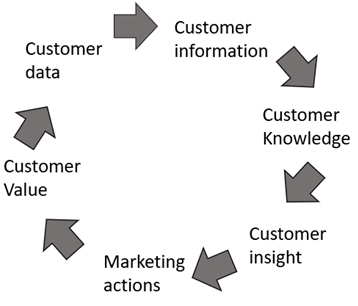
Enhancing Business Development Through Improved Customer Data Utilization
Understanding customer needs and the business environment is critical for any business, as it has a direct impact on success and growth. Also, it is crucial to be mindful of the customer wants and preferences for a company’s long-term success and growth. This supports the development of products and services, the cultivation of customer loyalty, the creation of competitive edge, and, ultimately, the promotion of market success.
How is it possible to figure out what customers’ needs and preferences are? There are many ways, but the one we would like to talk about here is the data what businesses are collecting, or should collect. Businesses should collect the data which should be thoroughly analysed and processed into useful customer information. Information helps business to gain customer knowledge and finally has understanding about the customer insight. To generate customer insight, Bailey (2020) states that data, behaviour, and feedback from the market, competitors, and customers are analysed and understood. Gaining a comprehensive understanding about the customers’ attitudes, needs, and relationships with brands, along with the factors that influence their purchasing decisions, is made possible by customer insight.
Customer data
This article is based on information about customer data and its processing within the company in the global business environment. Information about how the company collects and uses customer data was collected by interviewing the people who are working within the customer interface. The results were interesting. Customer data is collected quite comprehensively using different channels, but based on the results, it can also be concluded that the data is not used in a way that would generate as much value as possible for the company. There is useful data in various places, but accessing it is somewhat difficult or it is not known exactly where the data is located. As a result of inefficient data management, the data cannot be analysed in a way which would generate useful customer information and knowledge.
Processing and using the customer data
A link between the acquired data and decision-making is necessary if the company’s objective is to go from gathering and archiving data to using it in decision-making. The organization must critically consider if the right data is being gathered, whether it is of a good quality, and whether it is being used in the right contexts in particular situations. One element unites many success stories: the information is acquired over an extended period of time. In this way, companies lay the groundwork for analysis and informed decision-making (Arantalo, 2006.) Based on this research the suggestion is that one useful and usable way to process collected data is to use an iterative process where from the customer data it is finally refined into customer value. In Figure 1, the simple iterative process also known as data-to-value cycle presented by Smith, Wilson and Clark (2006) shows how the data is refined in the process.

The process can be presented in different ways, such as vertically or horizontally, what best suits the company’s needs. Anyhow, when a company has a clear process for analysing customer data, sales and marketing actions are easier to implement and are more useful. And finally, what is the most important is creating value for the customer more efficiently. Smith et al., (2006) propose the following definitions for each step in the data-to-value cycle.
- Customer data refers to the recorded transactions or contacts with customers, whether explicit, implicit, quantitative, or qualitative.
- Customer information is data that has been categorized into patterns.
- Customer knowledge refers to contextualized information tailored to the customer’s needs.
- Customer insight is an organizational strength that is unique, valuable, difficult to imitate, and aligned with the organization’s aims.
- Marketing activities are changes to a product or service that significantly impact the consumer experience.
- Customer value refers to how marketing influences a customer’s decision to purchase a product or service.
Using the customer insight
Utilizing customer data for insight is crucial for businesses, but it is also essential that insight supports quick decisions for growth and development. Even while many organizations have a lot of data, many do not have the resources, such as personnel, equipment, or expertise necessary to convert that data into actions that would help them become insights-driven businesses. Bailey (2020.) As mentioned earlier in this article, in this particular case the customer data and information are gathered, but because of the insufficient utilization and analysis of the data, the organization may not benefit as much as they could from the data and that causes the inefficient use of the process toward customer insight driven company.
Conclusion
Companies must have a strategy for how customer data is collected and how it is analysed. Many companies collect huge amounts of data from different sources, but it is often stored in a disorganized manner and there is no efficient access to it. Today, data is a company’s one of most important assets and it must be used appropriately. Otherwise, one important tool against rivals will remain unused.
- Arantola, H. (2006). Customer Insight—Uusi väline liiketoiminnan kehittämiseen. Helsinki: Sanoma Pro.
- Bailey, C. (2020). Customer insight strategies: How to understand your audience and create remarkable marketing. London: Kogan Page Publishers.
- Laaksonen, M. 2024: The improved usage of customer data when going toward the utilization of customer insight in business development. M.Sc. Thesis, Turku University of Applied Sciences.
- Smith, B., Wilson, H., & Clark, M. (2006). Creating and using customer insight: 12 Rules of best practice. Journal of Medical Marketing, 6(2), 135–139. https://doi.org/10.1057/palgrave.jmm.5050013